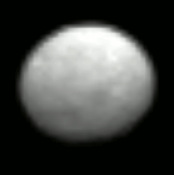2015 will be relatively full, as years go, of space exploration. Not only will we finally get our first pictures of Pluto later this year, but the Dawn probe will become the first probe to image a dwarf planet in detail, and observe the only object in the Asteroid Belt with enough mass to pull itself into a sphere. On January 13th, the Dawn probe imaged Ceres for the first time with a higher resolution than any telescope before. Although it didn't reveal much about Ceres's surface that we don't already know, it shows the beginning of the approach to Ceres in the next month. In only one month and 11 days we will have unprecedented images of Ceres, revealing all the details of this elusive dwarf planet.
Speaking of details, many images of Ceres have revealed what appears to be a bright spot near Ceres's equator. It's certainly not a temporary feature, as images of Ceres from both the Hubble Telescope and Dawn, spaced over 10 years apart, show the same feature:
Ceres as taken by the Hubble Telescope in 2003-2004
So, let's do somethinking.
In 2003-2004 the object, whatever it was, was much more visible and bright than it is now. Plus the object appears to be inside a crater from the Dawn image.
Firstly, it could be ice. Craters have been known to be filled with ice previously. Ceres is likely no exception. However this ice deposit is near the equator, which would mean that it would have boiled away by now. Any source of ice would have to be replenished constantly, perhaps by the recently-discovered theoretical subsurface ocean.
On the topic of ice brings me to the second possibility. Earlier Hubble had observed ice around Ceres, in the atmosphere around it. This may be a geyser fueling the cloud of ice around Ceres. However it doesn't appear to have much of a height to it.
Either way, we'll find out what it is eventually when we reach Ceres. Perhaps it's just a gigantic sticker.

